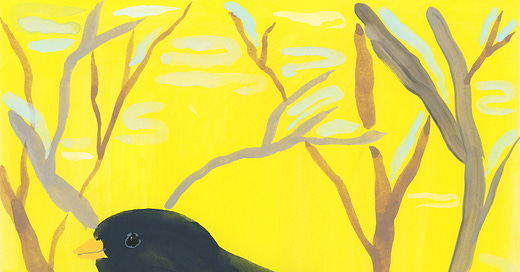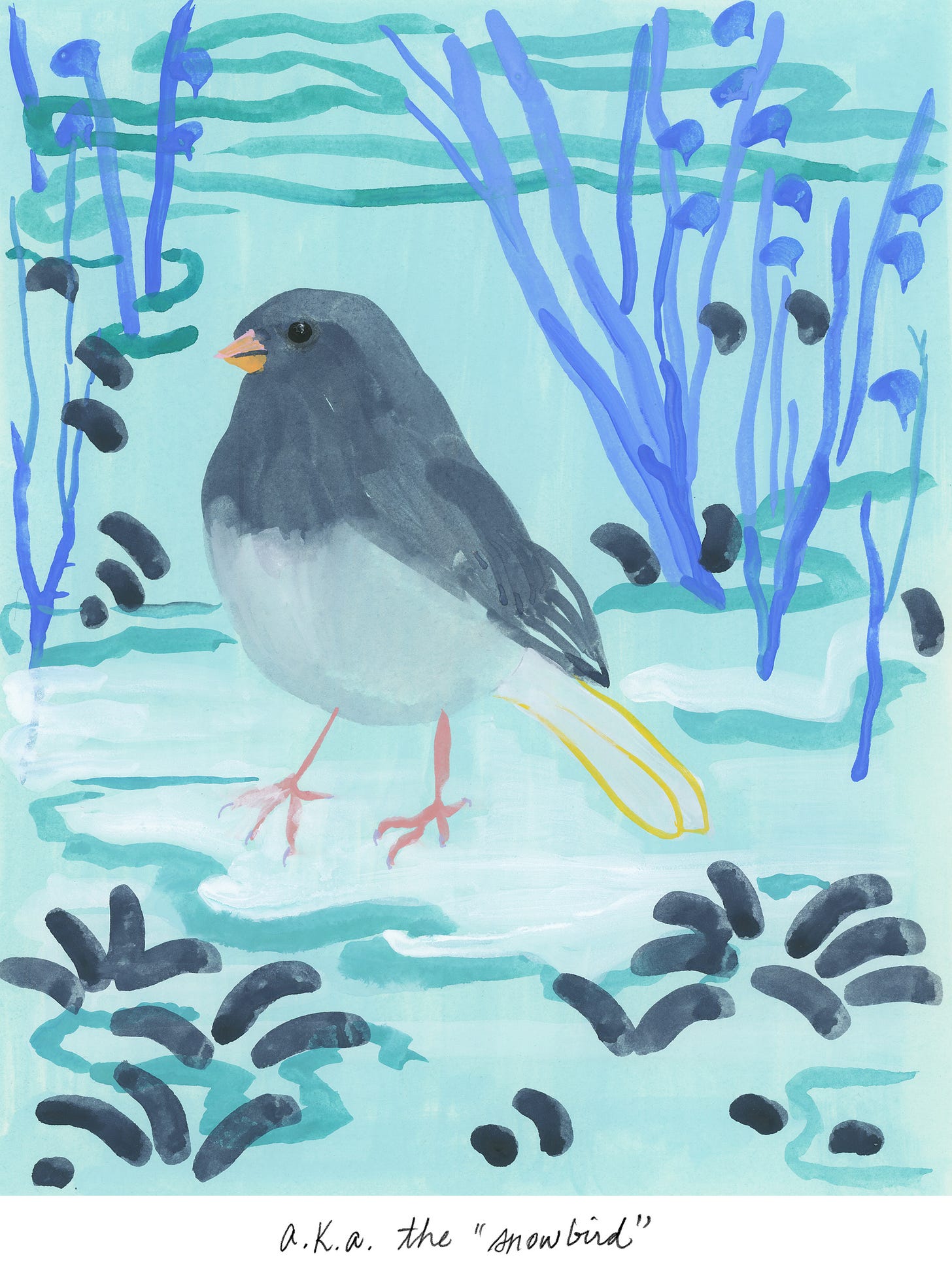Hi, friends — it’s a wintry mix, issue #13 of my newsletter about animal encounters. Please add your small bird stories to the comments, or you can always reply directly to this email. Thanks! — AJP
We’ve had a couple of snowstorms this week—beautiful, reasonably non-terrifying ones, with fluffy picture-postcard snow. Looking out the window, in the middle of one of them, with snow falling in that hazy dreamlike way that it does, I was surprised to see a small gray bird huddled at the bird feeder.
I saw its melon-colored beak and black eyes, turning gently and picking a seed or two. Another three or four of the same bird were perched in a nearby tree. They seemed relaxed, in a way that did not feel like winter. Honestly, they reminded me of people dangling their legs in a swimming pool—just, chill.
Dark-eyed juncos always have an effect on me. I might not realize how wound-up I am, truly, until I see them out the window. They are not flashy; they move in a kind of methodical, patient way; they seem so gentle and beyond the fray. And there they are, out in the middle of a snowstorm (they’re literally the only ones out in the middle of a snowstorm). Their fortitude slows me down by about a thousand.
Many birds migrate south to avoid the disasters of winter. Some populations of dark-eyed junco seem to have a different strategy. They manage just fine in the snow and, for them, places like Connecticut and Chicago are warm enough. Females migrate farther south, in general, while males stay north, possibly to get a jump on spring breeding grounds, which can range up to the Arctic Circle.
Juncos flock together in winter and keep warm in the evergreens at night. They have a pecking order and will establish dominance within their flocks, males over females, age over youth. I’ve seen a few confrontations featuring flashy white tail feathers, but mainly, from about October to April, I see them hopping over the earth, getting on with the business of life, not minding the rabble of other birds around them.
Dark-eyed juncos are very common across North America, though they look different from region to region. Here in the eastern United States, they're slate-colored, while in western regions they are ruddy red, for example. If you notice one, you'll probably find another few close by—in backyards and bird feeders, city parks, cemeteries, and woodlands. They connect our habitats; they connect us all. Just about everyone in the United States can look out and see one this time of year. Though common, and with large populations, their numbers have declined in recent years (habitat destruction and climate change are major factors).
As we approach the anniversary of a year in a bottle (possibly still lost at sea, possibly coming to shore), I realize how important these little birds have been to me. They have grounded me, again and again, just by seeing them out there, sitting easily in the trees, in the middle of a snowstorm, getting on with the business of life.
Dark-eyed junco links—
Lots of videos out there, but here’s a short one including a baby chick, and a longer one that shows them scratching in the snow [YouTube]
Plus a sweet one of an Oregon junco singing (my heartstrings for spring)
“…for scientists who study animal behavior, ecology, and evolutionary biology, the Junco is a rockstar.” For a fascinating deep dive into evolutionary biology, see “Ordinary Extraordinary Junco” from Indiana University.
This weekend Feb. 12–15 is the Great Backyard Bird Count, a truly global event—you can easily join in (minimum 15 minutes is all), or just watch the real-time results from all over the world.
Animal encounters in recent comments—
If you click on anything, please read this incredible story from Jake and Sunny, who rescued a great-horned owl from a soccer net. “It was amazing—he looked right in my eyes the whole time …” Thanks to you both!
Also—
The empty trees are full of birds at the moment, so I think I’ll stick with birds and finally come back to mourning doves next week.
My drawings are for sale; please reply if you’re interested (I’m supporting Bird Note this week). I also have a couple of bird prints at 20x200 (with a nice discount through Tuesday).
If you’re dreaming of spring gardens, here’s a handy resource from Audubon about native plants in your area.
Thank you for reading and sharing with friends and family. This newsletter is a small weekly adventure about the life around us.







Love the notion of the birds just “hopping over the earth, getting on with the business of life”. That many animals are probably experiencing this moment as a curious pattern change, absent all its weird rancor, brings me some peace.
P.S. Thanks for the shoutout :) 💛
A few dark eyed juncos at my feeder in the snow today, an hour southwest of Toronto. They are so cute; I love their shape and ombré pattern!